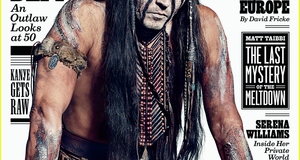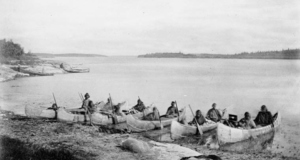Featured Article:Controversial Kin: Transracial Adoption in "Hope Leslie" and "Ramona"Comparing White and Native American Adoption Practices in Hope LeslieIn Hope Leslie, Alice and Mary Leslie are left fatherless after Charles Leslie, a man their mother was compelled to marry, “perished in foreign service,” prompting the family’s trip to the new world (Sedgwick, 1827, p. 20). The girls then become complete orphans after their mother dies from illness onboard the ship on its way to America. Shortly before her death, their mother willed her two children to be adopted into the care of William Fletcher, a cousin she was previously affianced to. And though traditional thinking claims that adults cannot be orphaned, William Fletcher does become an orphan at an adult age while still in England, as “[h]is father died a few hours before he arrived at the paternal mansion. … His mother had been long dead; and he had neither brother nor sister” (Sedgwick, 1827, p. 9). After his engagement to Alice had broken off, Fletcher left for the new world and was “persuaded to unite himself with [the] orphan girl,” Martha, in marriage (Sedgwick, 1827, p. 12). Governor John Winthrop had adopted Martha as a child, and later in the narrative, Winthrop also adopts Ester Downing, his pious niece, as well as Hope Leslie into his household. As Wayne Carp (2002) finds in his comprehensive study, Adoption in America, the distinction between apprenticeships, indentured service, and actual adoption was not completely separate from the seventeenth through the early nineteenth century. Hope Leslie demonstrates the reality of this when William Fletcher, who shortly before describes the adoption of Alice Leslie’s children as a guardianship, later states Faith and Hope Leslie will “bring additional labour” to Martha’s household (Sedgwick 20). And in Sedgwick’s own time, adoption was also frequently practiced, though informally, because the first adoption law would not be set down for another 24 years (Kawashima, 1981, p. 677). This is most likely why what contemporary readers would deem adoptions, Sedgwick names “guardianships” and children are called “servants,” when they are cared for as adopted children. It is for this exact reason that readers most likely skip over the “captive” adoptions in Hope Leslie and deem them mere servanthood or captivity and confinement. But if white adopters treated white adoptees like indentured servants, it is hard to expect that transracial adoptees would be treated any less like indentured servants in a time the nation was fighting to keep racial hierarchies intact. The first instance of a transracial “captive” adoption occurs when Magawisca’s and Oneco’s mother, Monoca, petitions for the well-being of her children on her deathbed. In response, Governor John Winthrop, “redeemed her children, and assured her they should be cared for” (Sedgwick, 1827, p. 25). Instead of returning the children to their tribe or back to their father, where the siblings would be restored to their biological families, Winthrop “procured” the Indian siblings to be servants for the Fletcher household (Sedgwick, 1827, p. 20). And though Magawisca does not choose to live in the Fletcher household by her own agency, the text never mentions anyone using chains or violence to force Magawisca into the home. Furthermore, the text’s word choice of procure, which means to “obtain by particular care and effort” points to the fact that Magawisca’s stay in the Fletcher household is intended to be more than servanthood (“procure”). In actuality, it is meant to resemble an adoption.But Magawisca’s captivity/adoption is not the only time Sedgwick explores transracial adoption. Shortly after Magawisca leaves the Fletcher’s home, Magawisca’s tribe captures the white, English-born Faith Leslie and raises her up their society. After her capture, Faith does not resurface again until volume two of the novel, where, by this time, she is fully assimilated into the Pequod tribe, has no remembrance of the English language, and is Oneco’s “white bird” as his wife (Sedgwick, 1827, p. 237). How Faith became acculturated into a completely different kind of community is left up for the reader to imagine, however, because Hope Leslie never explains how the transformation comes about. What Hope and readers do know, though, is that Faith actually prefers her new culture to her previous one, even after Hope Leslie offers Faith various incentives to leave the Peqoud tribe. Historically, this occurrence of the “unredeemed captive,” a EuroAmerican that had been captured by Native Americans, who then assimilated into the tribe and refused to leave once given the chance, was a well-known phenomenon in the seventeenth century and a subject eighteenth- and nineteenth-century authors frequently wrote about when exploring America’s origins (Jerng, 2010, p. 7). Native American tribes did not simply capture EuroAmericans as acts of revenge but instead frequently took whites in order to adopt them. Diseases had wiped out large portions of many Native American tribes, and these captured colonists were meant to take up the place of tribe members who had recently died (Rifkin, 2011, p. 122). Like Hope, however, colonists were not often aware of this fact and were mystified at how a white Puritan could transform from captured person to a fully acculturated Indian over the course of a few years. What most colonists found even more remarkable, however, was how readily EuroAmericans embraced life in Native American cultures, while Native Americans brought into white societies almost always resisted the change in culture and unhesitatingly left if the opportunity arose. To explain this occurrence, contemporary historians and literary scholars often look to the two very different ways European colonists and Native American tribes claimed the “Other” as kin through adoption. In his study of transracial adoption throughout American literature, Claiming Others: Transracial Adoption and National Belonging, Mark Jerng (2010) finds that colonists implemented adoption in an “as if” manner, where deceased children were seen as irreplaceable and adoptees were treated as if they were kin, but were recognized as genealogically and historically alien to the adoptive family (p. 30). In contrast, Native Americans actually substituted adoptees in place of lost members of the tribe, where the adoptee became socially identical to the person they replaced and became real kin. In addition, the adoptee’s race mattered little in how Native Americans treated the person before or after the adoption ceremony. Essentially, Indians would forever be recognized as an “Other,” while whites were recognized as true members of the tribe (Jerng, 2010, p. 21). Knowing the distinction between white and Native American ideologies about adoption also helps explain why unredeemed captives like Faith Leslie made nineteenth- century America deeply anxious about race relations. According to Native American substitutive adoption, races and genes were not very significant, which dissolved the dichotomy of the “human, civilized” whites and “animalistic, savage” Indians (Jerng, 2010, p. 3). Thus, Hope Leslie becomes an especially significant text for examination because it was one of the few nineteenth-century novels that actually placed white and Native American adoption practices adjacent to each other for direct comparison. Another text of the time, Lydia Maria Child’s Hobomok: A Tale of Early Times (1824), also looks at transracial adoption, but this text gives no example of same-race adoption for readers to compare Native American adoption practices with white adoption practices. In Hope Leslie, Magawisca is definitely cared for during her stay in the Fletcher household, but when given the chance, she flees with her biological family and returns to her native home. When Faith is put in the same position, however, she stays put with her new adoptive family. Thus, readers can clearly see the distinction between the two captivities/adoptions for themselves. Ultimately, the comparison implies that something is broken in white adoptive and assimilation practices. Particularly, white adoptive practices did not allow for any transformation of identity; Magawisca arrives in the Fletcher household as a Pequod girl, and though she is cared for and temporarily adopted, she never technically becomes part of the Fletcher family, does not become a colonist, and does not become “American.” Because Magawisca’s identity remains stagnant, it is obvious why she does not think twice about running away from her adoptive family and returning to her biological one. In contrast, when Faith is brought into the Peqoud tribe, she becomes conjugally tied to a Native American, changes her religion, changes her language of choice, and even metaphorically changes her race. It is not as if Faith is one of the Pequods; she is one of the Peqouds. Rather than merely bringing her in for adoption, the Pequod tribe has transformed Faith. The text is progressive in so much that it sees cross-cultural care between whites and Native Americans as a better ethical paradigm than cross-racial violence. Faith Leslie is never harmed, and though Magawisca must endure an unmerited jail sentence, she too comes to the denouement of the text physically unharmed. And through Magawisca’s adoption, the white Fletchers come to a better understanding of Native American culture, and the family realizes Magawisca’s humanity. This new appreciative outlook, however, is ruined when the Pequod tribe incites violence on the household, killing a mother and child. Thus, Sedgwick powerfully juxtaposes familial peace and domestic tranquility with chaotic violence and death. Overall, the text does realize that caring for Native Americans with white “as if” care would not be enough to dissolve racial boundaries and bring an end to the warring between the two peoples. Hope Leslie fairly successfully demonstrates that Native American adoption practices were much more efficacious at making an “Other” part of their society. Sedgwick was one of the few early nineteenth-century female writers to bring to light this difference, but she would not be the last of the era to do so.Continued on Next Page » Suggested Reading from Inquiries Journal
Inquiries Journal provides undergraduate and graduate students around the world a platform for the wide dissemination of academic work over a range of core disciplines. Representing the work of students from hundreds of institutions around the globe, Inquiries Journal's large database of academic articles is completely free. Learn more | Blog | Submit Latest in Literature |
















